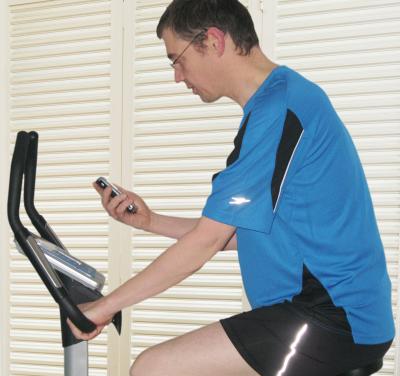Home > Press > Lactate test made easy
 |
| Fitness levels are indicated by the lactate value. At present, athletes have to pedal on a cycle ergometer while a doctor takes blood samples. Things will be easier in future.
Credit: © Fraunhofer IMS |
Abstract:
Performance athletes need to know their blood lactate level. It indicates how much lactic acid has collected in their blood as a result of physical exertion and enables conclusions to be drawn about their fitness. Professional athletes therefore regularly have to attend performance diagnosis sessions. As they pedal a cycle ergometer at various levels of exertion, a doctor takes blood samples from an earlobe. A special device then measures the concentration of lactate in the blood.
Lactate test made easy
Germany | Posted on May 6th, 2009Such scenarios will soon be a thing of the past. Using a miniaturized measuring system, performance and leisure athletes will in future be able to monitor their lactate readings themselves - including during training. Normally the analytical devices are quite big and cost several thousand euros. "We have found a way of miniaturizing the measurement system so that it can be accommodated in an ear clip. The results could be radioed by the ear clip to a training wristwatch or a cellphone," says Thomas van den Boom, group manager at the Fraunhofer Institute for Microelectronic Circuits and Systems IMS in Duisburg. An electrochemical method is used to measure the lactate value. In a chemical reaction, an enzyme triggers a redox flow from the lactate which can be measured using electrodes. The measurement system, which could be installed for example in an ear clip, consists of two microchips: the innovative nanopotentiostat fits on a chip measuring just two by three millimeters and costs less than one euro. "The second chip incorporates microelectrodes which we have developed for this purpose and which we can couple with the nanopotentiostat," explains van den Boom. One of the microelectrodes is coated with a thin layer of gel containing the enzyme. There are altogether three microelectrodes on the chip, which are activated by the nanopotentiostat. Two serve the purpose of electrochemical measurement while the third keeps the electrochemical potential constant end thus ensures a stable voltage.
The engineers can coat the electrode with different enzymes so that, apart from lactate measurement, various other analyses can be performed in the blood or other electrolytes. The advantage is that the electrodes are very small and cheap - and the analyses can be carried out in a mobile environment. A first demonstrator of the nanopotentiostat for lactate measurement (without earclip) has already been produced.
####
For more information, please click here
Contacts:
Thomas van den Boom
49-203-378-3207
Copyright © Fraunhofer-Gesellschaft
If you have a comment, please Contact us.Issuers of news releases, not 7th Wave, Inc. or Nanotechnology Now, are solely responsible for the accuracy of the content.
| Related News Press |
News and information
![]() Simulating magnetization in a Heisenberg quantum spin chain April 5th, 2024
Simulating magnetization in a Heisenberg quantum spin chain April 5th, 2024
![]() NRL charters Navy’s quantum inertial navigation path to reduce drift April 5th, 2024
NRL charters Navy’s quantum inertial navigation path to reduce drift April 5th, 2024
![]() Discovery points path to flash-like memory for storing qubits: Rice find could hasten development of nonvolatile quantum memory April 5th, 2024
Discovery points path to flash-like memory for storing qubits: Rice find could hasten development of nonvolatile quantum memory April 5th, 2024
Discoveries
![]() Chemical reactions can scramble quantum information as well as black holes April 5th, 2024
Chemical reactions can scramble quantum information as well as black holes April 5th, 2024
![]() New micromaterial releases nanoparticles that selectively destroy cancer cells April 5th, 2024
New micromaterial releases nanoparticles that selectively destroy cancer cells April 5th, 2024
![]() Utilizing palladium for addressing contact issues of buried oxide thin film transistors April 5th, 2024
Utilizing palladium for addressing contact issues of buried oxide thin film transistors April 5th, 2024
Announcements
![]() NRL charters Navy’s quantum inertial navigation path to reduce drift April 5th, 2024
NRL charters Navy’s quantum inertial navigation path to reduce drift April 5th, 2024
![]() Discovery points path to flash-like memory for storing qubits: Rice find could hasten development of nonvolatile quantum memory April 5th, 2024
Discovery points path to flash-like memory for storing qubits: Rice find could hasten development of nonvolatile quantum memory April 5th, 2024
Sports
![]() Surrey reveals its implantable biosensor that operates without batteries May 22nd, 2020
Surrey reveals its implantable biosensor that operates without batteries May 22nd, 2020
![]() Collagen nanofibrils in mammalian tissues get stronger with exercise December 14th, 2018
Collagen nanofibrils in mammalian tissues get stronger with exercise December 14th, 2018
![]() Epoxy compound gets a graphene bump: Rice scientists combine graphene foam, epoxy into tough, conductive composite November 14th, 2018
Epoxy compound gets a graphene bump: Rice scientists combine graphene foam, epoxy into tough, conductive composite November 14th, 2018
|
|
||
|
|
||
| The latest news from around the world, FREE | ||
|
|
||
|
|
||
| Premium Products | ||
|
|
||
|
Only the news you want to read!
Learn More |
||
|
|
||
|
Full-service, expert consulting
Learn More |
||
|
|
||








